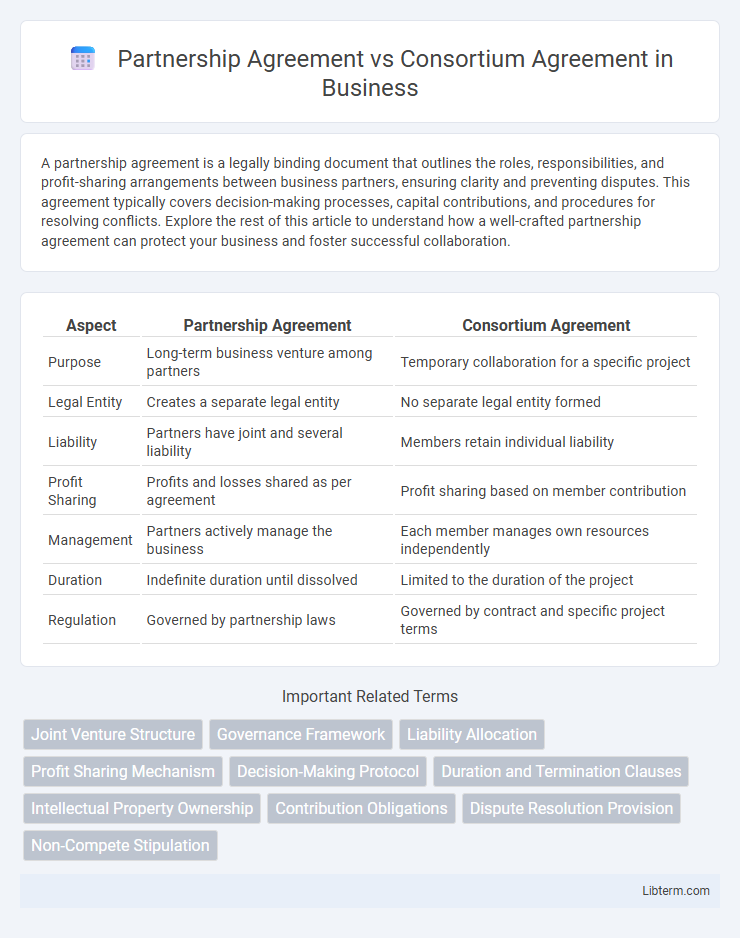A partnership agreement is a legally binding document that outlines the roles, responsibilities, and profit-sharing arrangements between business partners, ensuring clarity and preventing disputes. This agreement typically covers decision-making processes, capital contributions, and procedures for resolving conflicts. Explore the rest of this article to understand how a well-crafted partnership agreement can protect your business and foster successful collaboration.
Table of Comparison
| Aspect | Partnership Agreement | Consortium Agreement |
|---|---|---|
| Purpose | Long-term business venture among partners | Temporary collaboration for a specific project |
| Legal Entity | Creates a separate legal entity | No separate legal entity formed |
| Liability | Partners have joint and several liability | Members retain individual liability |
| Profit Sharing | Profits and losses shared as per agreement | Profit sharing based on member contribution |
| Management | Partners actively manage the business | Each member manages own resources independently |
| Duration | Indefinite duration until dissolved | Limited to the duration of the project |
| Regulation | Governed by partnership laws | Governed by contract and specific project terms |
Introduction to Partnership and Consortium Agreements
Partnership agreements establish a formal relationship between two or more parties who agree to share profits, losses, and management responsibilities in a business venture. Consortium agreements involve multiple organizations collaborating on a specific project while maintaining their independent legal identities and sharing resources or expertise. Both agreements define roles, obligations, and contributions but differ in structure, liability, and purpose.
Defining Partnership Agreements
Partnership Agreements establish a formal relationship where two or more parties share profits, losses, and management responsibilities in a business venture. These agreements specify each partner's contributions, roles, liability, and decision-making authority to ensure clarity and legal compliance. Unlike Consortium Agreements, which often coordinate collaboration for a specific project without forming a separate legal entity, Partnership Agreements create a unified business entity with joint ownership and shared risk.
Understanding Consortium Agreements
Consortium agreements define a collaborative framework where multiple entities unite to achieve a specific project goal, often in research, development, or large-scale construction, sharing resources, risks, and responsibilities without forming a separate legal entity. Unlike partnership agreements, which establish a joint business relationship with shared profits and liabilities, consortium agreements emphasize coordination and cooperation while preserving each member's legal independence. Understanding consortium agreements involves recognizing their role in facilitating complex, multi-party projects through clear governance structures, intellectual property arrangements, and financial contributions.
Key Differences Between Partnership and Consortium Agreements
Partnership agreements define a legally binding relationship where partners share profits, losses, and liabilities jointly, often with unlimited personal liability. Consortium agreements typically establish a collaboration between independent entities for a specific project or goal, without creating a new legal entity or shared liability among members. Key differences include the extent of liability, duration (partnerships are usually ongoing, whereas consortia are temporary), and the level of integration and joint control over business operations.
Legal Structures and Responsibilities
Partnership agreements establish a formal legal structure where partners share liabilities, profits, and management responsibilities jointly, often under a unified business entity. Consortium agreements, by contrast, form less integrated collaborations where each party retains separate legal identities and is responsible for its individual obligations, typically for a specific project. The key difference lies in liability allocation, with partnerships exposing members to collective liability, while consortia limit responsibility to each participant's contributions.
Distribution of Profits and Liabilities
A Partnership Agreement typically involves joint ownership of profits and liabilities among partners, with each partner sharing equal responsibility unless otherwise specified. In contrast, a Consortium Agreement often defines profit distribution and liabilities according to each member's contribution and role, limiting individual liability to their agreed share. Partnership liabilities are usually joint and several, exposing each partner to full responsibility, whereas consortium members tend to have liability proportional to their participation in the consortium.
Decision-Making Mechanisms
Partnership agreements typically establish decision-making mechanisms based on mutual consent or majority voting among partners, ensuring collaborative control and shared responsibilities. Consortium agreements often grant decision authority to a steering committee or lead partner, streamlining choices for complex, multi-organization projects. These structured approaches optimize governance by balancing inclusivity with efficient resolution of disputes.
Duration and Termination Clauses
Partnership agreements typically feature flexible duration terms that may be ongoing or set for a specific period, with termination clauses allowing dissolution by mutual consent, breach of agreement, or completion of purpose. Consortium agreements often specify a fixed duration aligned with the project timeline, including detailed termination clauses addressing early withdrawal, failure to meet obligations, or force majeure events. Both agreements require clear provisions on notice periods and consequences of termination to minimize disputes and ensure smooth transitions.
Use Cases: When to Choose Each Agreement
Choose a Partnership Agreement when two or more parties intend to operate a business jointly, sharing profits, losses, and management responsibilities, commonly seen in small to medium enterprises or professional services like law or accounting firms. Opt for a Consortium Agreement when multiple organizations collaborate on a specific project, typically large-scale infrastructure, research, or development initiatives, allowing each entity to maintain independence while contributing resources and expertise. The selection depends on the desired level of legal integration and project scope, with partnerships emphasizing long-term business unity and consortia focusing on temporary, project-specific cooperation.
Conclusion: Selecting the Right Agreement for Your Collaboration
Choosing between a Partnership Agreement and a Consortium Agreement depends on the collaboration's structure, liability preferences, and project goals. A Partnership Agreement suits closely integrated ventures with shared liability and profits, while a Consortium Agreement is ideal for temporary collaborations retaining individual autonomy and limited joint risk. Assessing legal obligations, financial responsibilities, and operational control ensures the selected agreement aligns with the partners' strategic objectives and risk management needs.
Partnership Agreement Infographic

 libterm.com
libterm.com